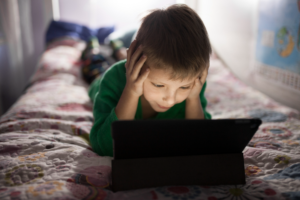In today’s world, children’s screen time has become a pressing concern for many parents. With the rise of digital devices, it’s hard to balance screen exposure. In this guide, we’ll explore practical ways to manage and reduce screen deaddiction in children. By understanding the root of the issue and exploring effective strategies, parents can create healthier habits for their kids.
Setting the Scene: Understanding the Digital Dilemma
Many kids spend hours daily on screens, whether watching videos, playing games, or scrolling. Statistics reveal that children aged 8–12 average about five hours a day of screen time, while teens might spend up to seven hours. COVID-19 only increased this dependency as kids used screens for school and social interaction. Many parents worry about how these changes affect their kids. They fear the specter of screen deaddiction in children taking shape and wonder how to reclaim balance.
Decoding Screen Addiction: Recognizing the Signs
Recognizing screen deaddiction in children starts with spotting changes in behavior. Kids might seem irritable when not using devices. They might prefer screens over socializing or playing outside. Physical signs can include eye strain or interrupted sleep patterns. Academically, a child’s performance may drop due to distraction.
Crafting the Right Environment: Age-Specific Screen Time Limits
Setting healthy screen limits varies by age. For ages 2-5, an hour a day is often recommended. Older kids should aim for about two hours. It’s vital to set rules that make sense and can be enforced. Collaborate with your children to establish rules, focusing on balanced use.
Nature vs. Nurture: Establishing a Screen-Free Home
Creating screen-free zones at home can help manage screen deaddiction in children. Bedrooms or dining areas can be designated screen-free. Parents play a role by leading by example and participating in activities like board games or crafts. Planning family movie or game nights can show kids that there are fun, screen-free options available.
Tech Solutions: Using Technology to Tame Technology
Harnessing technology can support parents in controlling screen deaddiction in children. Parental control apps can limit access and time. Time-tracking tools help monitor usage. Regularly update settings to ensure screen time practices remain healthy. These tools help parents guide children toward balanced technology use.
A Measured Path: Gradual Screen Deaddiction Strategies
Sudden removal of screens isn’t the best approach for managing screen deaddiction in children. Gradual reduction is more effective. Plan step-down techniques that slowly reduce time. Offering rewards for meeting reduced screen goals can be motivational.
Instilling Healthy Digital Habits: Building A Foundation for Life
Teach kids digital literacy, showing them how to consume content wisely. Encourage them to question and discuss what they learn online. Show them how to create a healthy digital balance between screen time and other activities. Building these habits can help prevent screen deaddiction in children in the long run.
Physical Engagement: Encouraging Outdoor and Team Activities
Encouraging kids to play outside is essential. Engaging in family outdoor trips, playing sports, or simply walking is vital for breaking screen deaddiction in children. Team sports foster social skills while keeping children active. Simple activities like bike riding or hiking also promote physical health.
Creative Ventures: Intellectual Alternatives to Screens
Investing in intellectual and creative pursuits provides great alternatives. Encourage your child to read books, paint, play music, or engage in puzzles. These activities stimulate the mind and reduce dependency on screens. These activities can significantly contribute to alleviating screen deaddiction in children.
Community Engagement: Building Support Systems
Community resources can support families dealing with screen deaddiction in children. Schools can organize workshops to discuss the importance of screen balance. Networking with other parents provides shared resources and strategies. Collaboratively, communities can foster a more balanced screen culture.
Handling Challenges: Tackling Resistance and Setbacks
Facing resistance is common when adjusting screen habits. Address conflicts calmly and stay consistent. Help children navigate peer pressure, emphasizing the balance of technology use. After setbacks, gently reintroduce changes and maintain open communication.
Real-Life Transformations: Success Stories and Insights
Stories of families who reduced screen deaddiction in children offer powerful insights. Some have seen communication improve and academic performance increase. These successes highlight the tangible benefits of adjusting screen habits. Learning from others’ experiences can inspire and provide guidance.
Towards a Balanced Digital Well-being: Conclusion
Consistency in small changes can lead to significant outcomes. Aim for a balanced, not restrictive, approach. Empower your kids to explore offline and embrace creativity. This journey towards digital well-being lays the foundation for a lifetime of healthy habits.






